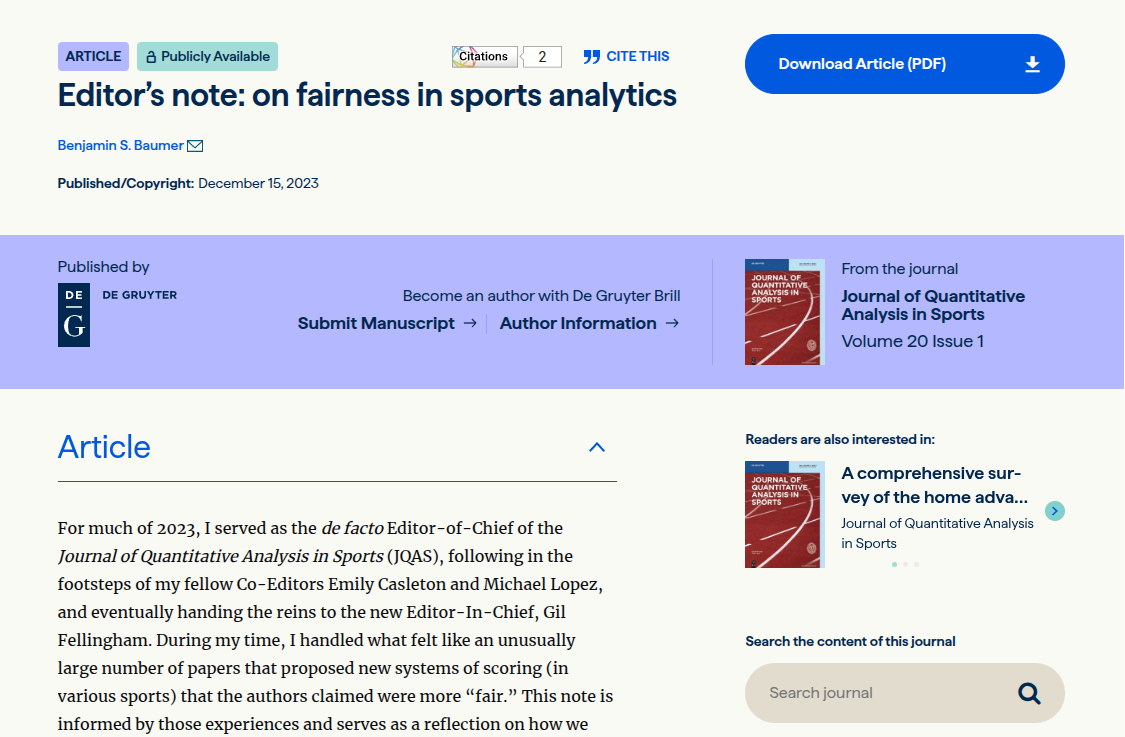| race | two_year_recid | risk_score | n |
|---|---|---|---|
| African-American | 0 | High | 345 |
| African-American | 0 | Low | 1169 |
| African-American | 1 | High | 843 |
| African-American | 1 | Low | 818 |
| Caucasian | 0 | High | 106 |
| Caucasian | 0 | Low | 1175 |
| Caucasian | 1 | High | 230 |
| Caucasian | 1 | Low | 592 |
Reward Systems in Sports
Who’s the Fairest of Them All?
Smith College
Sep 27, 2025
I wrote a thing…
On fairness in sports (Baumer 2024)

Equality vs. equity

Examples
Fairness in Machine Learning
COMPAS: recidivism scores
- \(Y\): Did they recidivate (within 2 years)
- \(\hat{Y}\): Did COMPAS label them high risk?
- \(A\): Protected class (i.e., race)
ProPublica (Angwin et al. 2016)
Prediction fails differently for Black Defendants
| Error Type | White | African-American |
|---|---|---|
| Labeled Higher Risk, But Didn't Re-Offend | 23.5 | 44.9 |
| labeled Lower Risk, Yet Did Re-Offend | 47.7 | 28.0 |
- ❌ COMPAS fails to demonstrate error rate parity
- ❌ COMPAS fails to demonstrate demographic parity
Northpointe
- 39-page rebuttal (Dieterich, Mendoza, and Brennan 2016)
- ProPublica misrepresents calculations
- ✅ COMPAS demonstrates predictive parity
\[ \Pr{(\neg Y | \hat{Y}, W)} = 0.409 \approx \Pr{(\neg Y | \hat{Y}, B)} = 0.370 \\ \Pr{(Y | \neg \hat{Y}, W)} = 0.288 \approx \Pr{(Y | \neg \hat{Y}, B)} = 0.448 \]
Statistical criteria for fairness
“Dozens” of statistical criteria for fairness boil down to 3:
- Independence
- Separation
- Sufficiency
Independence
- aka disparate impact
\[ \left| \Pr(\hat{Y} | W) - \Pr(\hat{Y} | B) \right| < \epsilon \,, \] where \(\epsilon\) is a small positive constant (typically \(\epsilon < 0.2\))
- ❌ COMPAS FAILS:
\[ \left| 0.348- 0.588 \right| = 0.210 > \epsilon \,, \]
Separation
- aka error rate parity
\[ \left| \Pr(\hat{Y} | Y, W) - \Pr(\hat{Y} | Y, B) \right| < \epsilon \\ \left| \Pr(\hat{Y} | \neg Y, W) - \Pr(\hat{Y} | \neg Y, B) \right| < \epsilon \]
- ❌ COMPAS FAILS:
\[ \left| 0.523 - 0.720 \right| = 0.197 < \epsilon \\ \left| 0.235 - 0.488 \right| = 0.253 > \epsilon \]
Sufficiency
- aka well-calibration
\[ \left| \Pr(Y | \hat{Y}, W) - \Pr(Y | \hat{Y}, B) \right| < \epsilon \,, \]
- ✅ COMPAS PASSES:
\[ \left| 0.591 - 0.630 \right| = 0.039 < \epsilon \]
Kleinberg’s impossibility theorem
Unless the base rates are the same across the groups, you can’t satisfy all three criteria simultaneously (Kleinberg, Mullainathan, and Raghavan 2016)
COMPAS summary
- ProPublica: COMPAS is biased because it lacks error rate parity
- Northpointe: Yeah, but it’s well-calibrated!
- Kleinberg: But since the base rates aren’t the same:
- …you’re both right
- …and you’re both wrong
- So is the algorithm fair or not??
Introducing faireR
- leverages
yardstickandmlr3fairness - computes independence, separation, and sufficiency
- mean absolute difference across groups
- visualizations
- data sets
tidyverse-friendly


Using faireR
Fairness IRL
The narrow view
People with similar qualifications should be treated similarly
- individual fairness
- Ex: the meritocracy, race-blind admissions, etc.
The broad view
People of equal ability and ambition should have similar chances
- fairness across groups
- Ex: all schools should be equally well-funded
The middle view
Adjust for past injustice (that caused the differences in qualifications) at the time of opportunity
- until recently, common interpretation in the US
- Ex: Texas 10% university admission policy (affirmed in 2016 and struck down in 2023)
What does this have to do with sports?
Providing vocabulary, Ex 1
Instead of:
two equal pairs should have as close to an equal chance of winning as possible. (Pollard, Noble, and Pollard 2022)
- We have a broad view of fairness
- We focus on sufficiency (aka well-calibration)
Providing vocabulary, Ex 2
Instead of:
A swimmer with no arms should be able to compete against a swimmer with one or two arms…If two athletes with the same disability compete, the more skilled and fitter should win. (Bartneck and Moltchanova 2024)
- We have a middle view of fairness
- Focus on separation and sufficiency
Providing vocabulary, Ex 3
Instead of:
We present two methods to distribute prize money across gender based on the individual performances w.r.t. gender-specific records. We suppose these “across gender distributions” to be fair, as they suitably respect that women generally are slower than men. (Martens and Starflinger 2022)
- We have a middle view of fairness
- Focus on independence
Called strikes in MLB

Are umpires fair to LHH?
- \(Y\): Was it a strike?
- \(\hat{Y}\): Was it called a strike?
- ✅ Independence
- ✅ Separation
- ✅ Sufficiency
A simple Hall of Fame classifier
- See Mills and Salaga (2011) for a more serious attempt…
Is the classifier fair w.r.t. batters and pitchers?
# A tibble: 1 × 3
independence separation sufficiency
<dbl> <dbl> <dbl>
1 0.00322 0.00520 0.0323✅
Is the classifier fair w.r.t. starters and relievers?
hof2025 |>
mutate(
is_pitcher = tSO > 100,
is_reliever = tSV > 50
) |>
filter(is_pitcher) |>
group_by(is_reliever) |>
fairness_cube()# A tibble: 1 × 3
independence separation sufficiency
<dbl> <dbl> <dbl>
1 0.00446 0.275 0.0821❌
Ironman Texas
Award prizes to:
- Naive: Fastest 20, regardless of gender
- Status Quo: Fastest 10 in each gender division
- Martens: Fastest 20 in relation to gender-specific world records
Texas Ironman naive

Texas Ironman status quo

Texas Ironman proposed

Texas Ironman fairness
# A tibble: 1 × 3
independence separation sufficiency
<dbl> <dbl> <dbl>
1 0.101 NA NAFuture work
- Visualize fairness in 2D
- ROC curves
- Calibration plots
- Visualize fairness in 3D
- Distance metric for overall fairness?
- Is mean absolute difference the best measure?
- Find additional suitable applications

